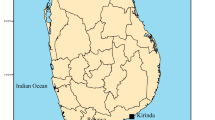Abstract
This study explored the effects of coastal vegetation on tsunami damage based on field observations carried out after the Indian Ocean tsunami on 26 December 2004. Study locations covered about 250 km (19 locations) on the southern coast of Sri Lanka and about 200 km (29 locations) on the Andaman coast of Thailand. The representative vegetation was classified into six types according to their habitat and the stand structures of the trees. The impact of vegetation structure on drag forces was analyzed using the observed characteristics of the tree species. The drag coefficient, including the vertical stand structures of trees, C d-all, and the vegetation thickness (cumulative trunk diameter of vegetation in the tsunami direction) per unit area, dN u (d: reference diameter of trees, N u : number of trees per unit area), varied greatly with the species classification. Based on the field survey and data analysis, Rhizophora apiculata and Rhizophora mucronata (hereafter R. apiculata-type), kinds of mangroves, and Pandanus odoratissimus, a representative tree that grows in beach sand, were found to be especially effective in providing protection from tsunami damage due to their complex aerial root structure. Two layers of vegetation in the vertical direction with P. odoratissimus and Casuarina equisetifolia and a horizontal vegetation structure of small and large diameter trees were also important for increasing drag and trapping floating objects, broken branches, houses, and people. The vertical structure also provided an effective soft landing for people washed up by the tsunami or for escaping when the tsunami waves hit, although its dN u is not large compared with R. apiculata-type and P. odoratissimus. In addition, the creeks inside mangroves and the gaps inside C. equisetifolia vegetation are assumed to be effective for retarding tsunami waves. This information should be considered in future coastal landscape planning, rehabilitation, and coastal resource management.












Similar content being viewed by others
References
Baker CJ (1980) The turbulent horseshoe vortex. J Wind Eng Ind Aerodyn 6:9–23
Dahdouh-Guebas F, Jayatissa LP, Di Nitto D, Bosire JO, Lo Seen D, Koedam N (2005) How effective were mangroves as a defence against the recent tsunami? Curr Biol 15(12):443–447
Fukuoka S, Fujita K (1990) Hydraulic effects of luxuriant vegetations on flood flow (in Japanese). Rep PWRI 180(3):64
Furukawa K, Wolanski E, Mueller H (1997) Currents and sediment transport in mangrove forests. Estuar Coast Shelf Sci 44:301–310
Hamzah L, Harada K, Imamura F (1999) Experimental and numerical study on the effect of mangrove to reduce tsunami. Tohoku J Nat Disaster Sci 35:127–132
Jayatissa LP, Dahdouh-Guebas F, Koedam N (2002a) A review of the floral composition and distribution of mangroves in Sri Lanka. Bot J Linn Soc 138:29–43
Jayatissa LP, Guero MC, Hettiarachchi S, Koedam N (2002b) Changes in vegetation cover and socio-economic transitions in a coastal lagoon (Kalametiya, Sri Lanka), as observed by teledetection and ground truthing, can be attributed to an upstream irrigation scheme. Env Dev Sustain 4:167–183
Kandasamy K, Narayanasamy R (2005) Coastal mangrove forests mitigated tsunami. Estuar Coast Shelf Sci 65(3):601–606
Kutija V, Hong HTM (1996) A numerical model for assessing the additional resistance to flow introduced by flexible vegetation. J Hydraul Res 34(1):99–114
Mazda Y, Magi M, Kogo M, Hong PN (1997a) Mangrove on coastal protection from waves in the Tong King Delta, Vietnam. Mangroves Salt Marshes 1:127–135
Mazda Y, Wolanski E, King B, Sase A, Ohtsuka D, Magi M (1997b) Drag force due to vegetation in mangrove swamps. Mangroves Salt Marshes 1:193–199
Melville BW, Sutherland AJ (1988) Design method for local scour at bridge piers. J Hydrau Eng ASCE 114:1210–1226
Nepf HM (1999) Drag, turbulence, and diffusion in flow through emergent vegetation. Water Resour Res 35(2):479–489
Sanit A, Gordon SM, Sonjai H, Somchai P (1992) Plants in mangroves. 120 pp, Bangkok
Shuto N (1987) The effectiveness and limit of tsunami control forests. Coast Eng Jpn 30(1):143–153
Tamai N, Asaeda T, Tanaka N (1987) Vortex structures around a hemispheric hump Bound-Layer Meteorol 39:301–314
Tanaka N, Takemura T, Shirono S (2005) Flow structures and sand deposition behind a colony-type grass on a gravel bar. Proc. XXXI IAHR, pp 2094–2103
Verheyden A, Dahdouh-Guebas F, Thomaes K, De Genst W, Hettiarachchi S, Koedam N (2002) High-resolution vegetation data for mangrove research as obtained from aerial photography. Env Dev Sustain 4:113–133
Wijetunge J (2005) Future directions for post-tsunami coastal zone management in Sri Lanka. Proc. XXXI IAHR, pp 4344–4352
Wolanski E, Jones M, Bunt SJ (1980) Hydrodynamics of a tidal creek-mangrove swamp system. Aust J Mar Freshwater Res 31:431–450
Acknowledgments
Dr. D.R.I.B. Werellagama, University of Peradeniya, and Dr. Nimal Wijerathne, Ruhuna University, are acknowledged for their useful suggestions during field investigations in Sri Lanka. For the field survey in Thailand, Prof. A. Sanit, Kasetsart University, and Dr. S. Havanond, Department of Marine and Coastal Resources of Thailand, are acknowledged for useful comments. The authors would like to thank Mr. Harsha, Mr. Yutani, Mr. Taengtong, and Ms. Wongsorn for their help in field measurements.
Author information
Authors and Affiliations
Corresponding author
Rights and permissions
About this article
Cite this article
Tanaka, N., Sasaki, Y., Mowjood, M.I.M. et al. Coastal vegetation structures and their functions in tsunami protection: experience of the recent Indian Ocean tsunami. Landscape Ecol Eng 3, 33–45 (2007). https://doi.org/10.1007/s11355-006-0013-9
Received:
Revised:
Accepted:
Published:
Issue Date:
DOI: https://doi.org/10.1007/s11355-006-0013-9




